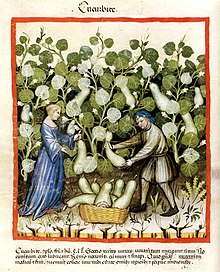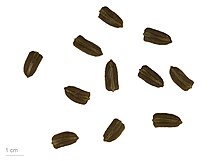Bottle gourd
| Bottle gourd | ||||||||||||
|---|---|---|---|---|---|---|---|---|---|---|---|---|

Bottle gourd ( Lagenaria siceraria ) |
||||||||||||
| Systematics | ||||||||||||
|
||||||||||||
| Scientific name | ||||||||||||
| Lagenaria siceraria | ||||||||||||
| ( Molina ) Standl. |
The bottle gourd ( Lagenaria siceraria ) is one of the oldest cultivated plants in the world and was in 2002 for vegetables of the year selected.
description
The bottle gourd is an annual climbing plant . The rungs are over 10 meters long. The stem axis is angular. The tendrils are in two parts. The leaves are large, heart-shaped and densely hairy on both sides. Their smell is said to be unpleasant. Two secretory glands sit at the transition point from the stalk to the leaf blade .
The bottle gourd is a monoecious gendered species ( monoecious ). The cultivated varieties have large, white solitary flowers with long pedicels. The flowers open during the night and are likely to be pollinated by moths , possibly also by cucumber beetles ( Diabrotica , Acalymma ) and other insects .
fruit
The fruits have a wide variety of shapes and sizes: the shape ranges from wide, spherical, pear-shaped, club-shaped, trowel-shaped to cylindrical. The smallest varieties have a diameter of five centimeters, the largest can be three meters long. The color ranges from light green with white speckles to white, with the bark turning light brown with age. Young fruits are hairy, they become bald when ripe. The bark is very dense and woody, it is very durable and waterproof. The flesh of unripe fruits is white and watery, paper when ripe. The seeds are large, brown, corky and of a peculiar, furrowed shape.
Chromosome number
The number of chromosomes is 2n = 22.
ingredients
The composition of the edible part of the fruit is average: 96.1% water, 0.6% fiber, 0.2% protein , 0.1% fat, 2.5% carbohydrates , 0.5% minerals.
distribution
The area of origin of the species is assumed to be in Africa , where the other species of the genus Lagenaria also occur. Zimbabwe is specifically named as home. The bottle gourd is pantropical. Its fruits, which can swim in salt water for a year without the seeds losing their ability to germinate, probably contributed to this.
Systematics
Two subspecies are distinguished within the species:
- Lagenaria siceraria subsp. siceraria includes the African and American varieties and land races.
- Lagenaria siceraria subsp. asiatica (Kobiakova) Hoarse includes the Asian forms.
history

The bottle gourd has been domesticated several times independently of one another. In America he was already 7000 BC. Used, the oldest finds come from Central America. After a first study of aDNA in 2005, the origin of American specimens through imports from Asia was considered very likely. On the other hand, there was no archaeological evidence along the immigration route on the assumed land route over the late glacial Beringland Bridge .
In 2014, an expanded study concluded that the examination of the DNA points to the origin of American specimens from Africa. The transatlantic drift from Africa to Central and South America was estimated to be at least nine months, but was described as plausible due to the ocean currents. The ability to germinate is retained for up to a year, so that a natural spread of the bottle gourds washed up from Africa in coastal regions of Central and South America is assumed.
The following sites show the earliest bottle gourd ages determined by radiocarbon dating :
- Guila Naquitz (Mexico), 10,000–9000 Before Present (BP) , corresponds to 7973-6808 cal Before Christ (BC)
- Awatsu-kotei (Japan), 9600 BP
- Quebrada Jaguay (Peru), 8400 BP
- Windover Bog (Florida, US), 8100 BP
- Coxcatlan Cave (Mexico), 7200 BP (5248-5200 cal BC)
- Paloma (Peru), 6500 BP
- Torihama (Japan), 6000 BP
- Shimo-yakebe (Japan), 5300 cal BP
- Sannai-Maruyama (Japan), associated date 2500 BC
- Te Niu (Easter Island), pollen, AD 1450
In Egypt it was not later than 2500 BC. Used. The bottle gourd also came from Africa to the European Mediterranean region.
Diocles of Karystos (4th century BC) writes that the best bottle gourds grow in the area of Magnesia (landscape in the east of Thessaly), and that it is "round and of enormous dimensions, sweet and easily digestible" (Athens. II 59a). Otherwise, special regional names had developed in Greek-speaking countries: Euthydemos (2nd century BC), doctor and writer, speaks in his book "About Vegetables" about the "Indian bottle gourd" because its seed comes from India (Athens. II 58f). The bottle gourd was called cucurbita by the Romans , a name that was later transferred to the genus of the pumpkin . Above all, Pliny the Elder mentions its use as a vessel. In the Middle Ages it was grown as a vegetable in large parts of Europe, but was later supplanted by pumpkins.
Cultivation
The bottle gourd is mainly grown in sunny, semi-arid lowlands, but can also be grown in the humid tropics on well-draining soils. Varieties with long, thin fruits are grown on trellises, but not those with heavy fruits. In dry periods it must be watered.
Young fruits can be pulled into certain shapes, knots are also possible. Unripe fruits are harvested 60 to 90 days after sowing. If the fruits are to ripen, they stay on the plant for at least a month longer. Average yields are around 25 tons per hectare.
Diseases and pests are usually of little importance. Viruses and powdery mildew can play a role, and anthracnose is particularly important in India.
In Austria it is or was grown in the wine-growing areas where the dried ripe fruits were used as a wine lifter.
use

The unripe fruits are often cooked and used as summer vegetables, for example in India, Italy and China. They are also used in curries. In Japan, the pulp of Lagenaria siceraria var. Hispida (Japanese 夕顔 , yūgao ) is cut into strips, dried and used as an edible casing, called Kanpyō, in dishes such as nimono or aemono and marinated in dashi , sugar and mirin for sushi . Shoot tips are used in China and Italy, for example. The seeds are ground into a kind of vegetable curd cheese.
The ripe fruits were and are used as vessels for storing food ( calabash ). Since they are waterproof, liquids are also stored in them. In Kenya they are used as milking pails by the Maasai . In China, small bottle gourds used to be used as “terrariums” for barbecues, while their use as bird houses was more common. Bottle gourds were used as penis cases in New Guinea, South America, and Africa . In several regions independently, the tradition of decorating bottle gourds with carvings arose. The Inca tradition is still continued in Peru today (as mate burilado ): the surface of the pumpkin is browned to varying degrees with glowing wooden sticks. Light tones are achieved by carving out.
The bottle gourd is also widely used to build musical instruments. These include stringed instruments such as the kora , sitar , berimbau and vessel rattles such as the maracas . More than 60 different wind, plucked and percussion instruments are made from the bottle gourd. In western Hungary , the missing double reed instrument Töröksíp with a bagpipe-like sound was partly built from the bottle gourd under the name regössíp .

The bottle gourd has long had an important role in herbal medicine, especially in Asia. The ripe fruits are used as a diuretic , emetic, and antipyretic . Leaves, seeds and flowers were used for various healing purposes all over the tropics. Guha and Sen also name the following areas of application: burns, jaundice and as a laxative.
The occasional opinion that the bottle gourd ( Lagenaria siceraria ) is contraceptive is not true. The opinion is based on a confusion with the related species Lagenaria breviflora . Scientific studies have shown that the latter inhibits the implantation of the fertilized egg .
In Turkey, the bottle gourd is used for decorative lamp manufacture Kabak Lamba .
Common names
For the bottle gourd, in addition to pumpkin (from Middle High German kürbiz ), the other German-language trivial names Herkuleskeule, Hiewerkerbes ( Transylvania ), Jonas gourd, club gourd, trumpet gourd and Zähkerbes (Transylvania) exist or existed . See also pumpkins # The pumpkin in common German names .
literature
- RW Robinson, DS Decker-Walters: Cucurbits . CAB International, Wallingford 1997, p. 60. ISBN 0-85199-133-5 (characteristics, cultivation)
- M. Pitrat, M. Chauvet, C. Foury: Diversity, history and production of cultivated cucurbits . In: K. Abak, S. Büyükalaca: Proceedings of the First International Symposium on Cucurbits . Acta Horticultae, Volume 492, 1999, pp. 21-29. ISSN 0567-7572 (history)
- TJH Chappel: Decorated Gourds in North-Eastern Nigeria , The Nigerian Museum, Lagos, Nigeria 1977, ISBN 0-905788-02-8 .
- CB Heiser Jr .: The Gourd Book . University of Oklahoma Press, Norman, Oklahoma 1979.
Individual evidence
- ↑ Lagenaria siceraria at Tropicos.org. In: IPCN Chromosome Reports . Missouri Botanical Garden, St. Louis
- ↑ a b J. Guha, SP Sen: Physiology, biochemistry and medicinal importance . In: NM Nayar, TA More: Cucurbits . Science Publishers, Enfield 1998, pp. 97-127. ISBN 1-57808-003-7
- ↑ Lagenaria in the Germplasm Resources Information Network (GRIN), USDA , ARS , National Genetic Resources Program. National Germplasm Resources Laboratory, Beltsville, Maryland. Retrieved January 18, 2017.
- ↑ Erickson, David L .; Smith, Bruce D.; Clarke, Andrew C .; Sandweiss, Daniel H .; Tuross, Noreen: An Asian origin for a 10,000-year-old domesticated plant in the Americas. Proceedings of the National Academy of Sciences Vol. 102, No. 51, 2005, pp. 18315-18320
- ↑ L. Kistler, A. Montenegro, BD Smith, JA Gifford, RE Green, LA Newsom, B. Shapiro: Transoceanic drift and the domestication of African bottle gourds in the Americas. In: Proceedings of the National Academy of Sciences. doi : 10.1073 / pnas.1318678111 .
- ↑ K. Kris Hirst: Domestication History of the Bottle Gourd (About.com Archeology)
- ^ Manfred A. Fischer , Karl Oswald, Wolfgang Adler: Excursion flora for Austria, Liechtenstein and South Tyrol. 3rd, improved edition. State of Upper Austria, Biology Center of the Upper Austrian State Museums, Linz 2008, ISBN 978-3-85474-187-9 .
- ↑ Kanpyo Calabash | Authentic Japanese product. In: japan-brand.jnto.go.jp. Retrieved January 13, 2017 .
- ↑ Summit, G. & Widess, J. 1999. Making gourd musical instruments: over 60 string, wind and percussion instruments, and how to play them . Sterling Publishing, New York.
- ↑ Magyar Néprajzi Lexicon - Hungarian Folklore Lexicon (Hungarian)
- ^ RW Robinson, DS Decker-Walters: Cucurbits . CAB International, Wallingford 1997, p. 91. ISBN 0-85199-133-5
- ↑ AA Elujoba, SO Olagbende, SK Adesina: anti-implantation activity of the fruit of Lagenaria breviflora Robert. J Ethnopharmacol . 1985, Volume 13, pp. 281-8. (Abstract)
- ↑ Muhammad Ali SARI: Kabak Avizeler. June 3, 2012, accessed October 23, 2016 .
- ^ Georg August Pritzel , Carl Jessen : The German folk names of plants. New contribution to the German linguistic treasure. Philipp Cohen, Hannover 1882, p. 120 ( online ).
Web links
- The bottle gourd was the 2002 Vegetable of the Year
- Lagenaria siceraria . In: S. Dressler, M. Schmidt, G. Zizka (Eds.): African plants - A Photo Guide. Senckenberg, Frankfurt / Main 2014.
- A short cultural history of the bottle gourd http://www.archaeologie-agentur.de/news/archaeo-blog/umgegraben-eine-archaeologie-der-garten Pflanzen/139-der-flaschenkuerbis.html


